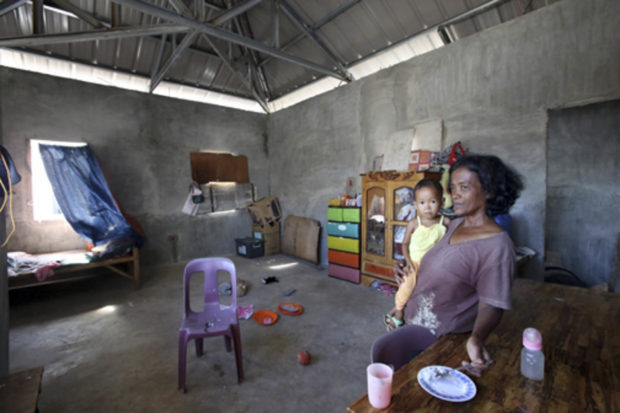
REHAB FAILURES Basion Eostrisimo is among the survivors of Supertyphoon “Yolanda” (international name: Haiyan) who have moved to a housing resettlement site at Santa Fe town on Cebu’s Bantayan Island. The World Bank has reportedweaknesses in the national government’s rehabilitation program. —JUNJIE MENDOZA/CEBU DAILY NEWS
A weak and nationally centered emergency management body, coordination problems between the national and local governments, as well as lack of a standard rehabilitation and recovery plan hampered the Philippine government’s response to Supertyphoon “Yolanda” (international name: Haiyan), according to the World Bank.
Almost four years after the strongest typhoon to hit land flattened Eastern Visayas, the World Bank published this month a policy note titled “Philippines: Lessons Learned from Yolanda — An Assessment of the Post-Yolanda Short and Medium-Term Recovery and Rehabilitation Interventions of the Government,” which identified what went wrong in the government’s response to the disaster.
Yolanda struck 171 cities and municipalities, affecting 12 million people. More than 900,000 families were displaced and more than 1 million houses damaged, leaving about 6,300 people dead, 1,000 missing and 28,000 injured.
The World Bank determined that Yolanda’s onslaught slashed 0.9 percent from the gross domestic product growth of the Philippines in 2013 and 0.3 percent the following year.
The extensive damage also resulted in 2.3 million Filipinos falling below the poverty line, especially those in the ravaged areas of the country.
The World Bank pegged total damage and loss at P571.1 billion.
NDRRMC structure wrong
First among the problems identified by the World Bank post-Yolanda was that, “with the scale and impact” of the typhoon, the National Disaster Risk Reduction and Management Council (NDRRMC) was “not an appropriate vehicle for coordinating a response, rehabilitation and recovery effort.”
It said the current Philippine disaster risk reduction management (DRRM) law prescribed a council-structure composed of 42 member agencies that were limited to coordination, policymaking and oversight or advisory roles.
“The implementation of response, recovery and rehabilitation programs and projects is not integrated and cohesive. It is based on the respective mandates of the member agencies,” the World Bank said.
“With several major disasters, experience has shown that the existing law is not sufficient and the current structure has limited authority, resources and staff capacity” to deal with the impact, scale and rapidly evolving DRRM problems, it said.
So the Philippines needs to establish a national disaster risk reduction and management agency with a “stronger mandate to coordinate, plan, finance, implement and monitor all DRRM interventions—prevention and mitigation, preparedness, response, risk reduction and resilience, and rehabilitation and recovery,” according to the World Bank.
A “council-type” setup for an NDRRM agency “will not be able to effectively handle the increasing magnitude, scale and frequency of disasters in the Philippines,” it added.
It also did not help that “coordination issues in the response, rehabilitation and recovery interventions were glaring,” especially between the national and local governments, according to the lender.
Review systems
“The existing protocols, guidelines and mechanisms were not sufficient” to deal with the magnitude and impact of the disaster, it said.
Hence, the World Bank said, “it is crucial to review existing mechanisms and protocols and develop systems that will take into consideration the lessons learned from the Yolanda experience.”
It blamed the “severe delays” in the implementation of rehabilitation and recovery projects on a “national-centric” implementation system.
“The national government agencies were mandated to implement all recovery projects in the affected areas without additional staff complement and funding. This task was on top of their regular agency mandates and deliverables,” it said.
To solve implementation bottlenecks and speed up recovery, the lender said it was necessary to adopt implementation arrangements that allowed local governments and communities to actively participate and implement reconstruction projects with technical and financial support from national government agencies.
As for funding the reconstruction efforts, the World Bank said that “while the Yolanda Comprehensive Rehabilitation and Recovery Plan and its budget was approved by [then] President [Benigno Aquino III], there was no clear information on the sources of funds,” causing “delays in the agency budget requests and releases.”
For postdisaster recovery, the World Bank said it was important to develop a system that quickly identified the available funding sources and financing arrangements, “one that also provides options for quick access and use of government funds (national and local) and other available resources.”
Emergency procurement
The government also “[lacked] basic guidelines on how emergency procurement is applied,” while “an integrated public financial management system caused delays in the procurement and implementation of rehabilitation and recovery interventions,” the World Bank said.
“The Philippine Procurement Act and its implementing rules and regulations provide a general provision for negotiated procurement or emergency procurement in times of disasters or emergency. However, the national government agencies and local government units are cautious in applying this mode of procurement without specific guidelines for fear of the Commission on Audit sanctions and disallowance,” it said.